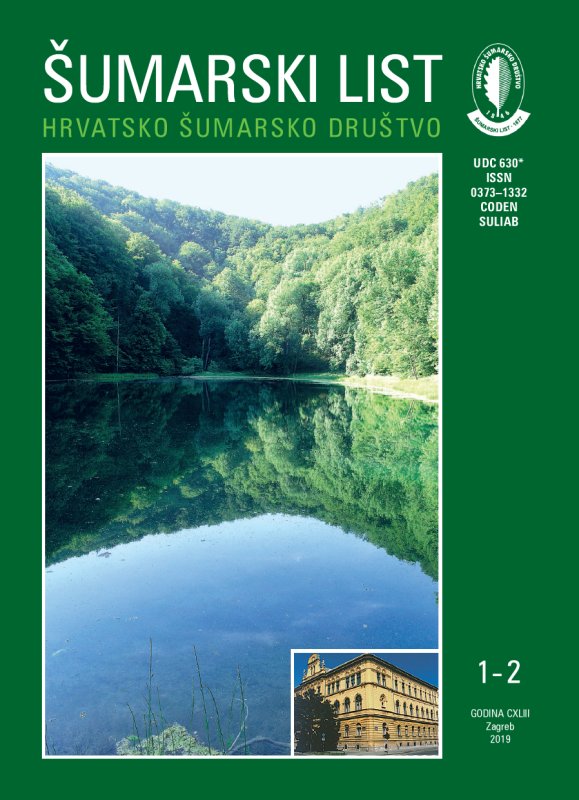
broj: 1-2/2019
pdf (11,35 MB) |
|
||||||||||||||
| RIJEČ UREDNIŠTVA | ||
| Uredništvo | ||
| Is the profession or the system to blame? pdf HR EN | 5 | |
| IZVORNI ZNANSTVENI ČLANCI | ||
| Marijana Žunić, Krunoslav Teslak | UDK 630* 923 + 94 (001) https://doi.org/10.31298/sl.143.1-2.1 | |
| Constraining factors of activities in Croatian forest estates – MIMIC model pdf HR EN | 7 | |
| Summary The purpose of this paper was to determine the share of active and inactive forest owners in Croatia and to identify potential causes for underuse of wood resources and their most important predictors based on inactive forest owners sample. We interviewed 1007 randomly selected forest owners on Croatian territory with a telephone survey. Of the total sample, 60% of forest owners believe that they efficiently manage their forests while 40% are inactive (Table 1). In order to determine the most important reasons and causes for inactive forest owners not cutting more, additional questions were asked. They were provided by 19 statements describing possible reasons for underuse of wood resources. Then, on Likert’s scale from 1 (not important at all) to 5 (very important) they expressed their level of agreement with a particular statement (Table 2). The statements were condensed into three dimensions by explanatory factor analysis with eigenvalue approach. Factors were interpreted as: (1) factor of qualifications and knowledge constraints, (2) factor of passiveness and forest conservation and (3) factor of physical constraints (Table 2). Statistically acceptable model was established by confirmatory factor analysis approach (Figure 2). The pronounced processes of structural changes in forest ownership composition, as well as in socio-demographic and forest property characteristics, are evident across Europe consequently influencing the intensity of private forest management. Within the aforementioned, we used gender, age, education, working status, the distance between the forest and the place of residence, the size of the settlement and the knowledge of forest property boundary lines as independent variables for management constraining factors model construction (Figure 1). Socio-demographic and forest property characteristics have been modeled with the extracted management constraining factors by applying a Multiple Indicators Multiple Causes (MIMIC) model (Figure 3). MIMIC model revealed that gender, age, and lack of boundary lines knowledge were the most important predictors for management constraining factors (Table 4). The notable part of forest owners in Croatia do not manage their forests because of insufficient knowledge and qualifications. Key words: private forest owners; management constraining factors; inactive forest owners; socio-demographic changes; MIMIC model | ||
| Luka Kasumović, Ake Lindelöw, Boris Hrašovec | UDK 630* 453 + 153 (001) https://doi.org/10.31298/sl.143.1-2.2 | |
| Overwintering strategy of Ips typographus L. (Coleoptera, Curculionidae, Scolytinae) in Croatian spruce forests on lowest elevation pdf HR EN | 19 | |
| Dalibor Ballian, Emir Lizdo, Faruk Bogunić | UDK 630* 587 (001) https://doi.org/10.31298/sl.143.1-2.3 | |
| Analysis of differences of growth and phenology of provenances of Scots pine (Pinus sylvestris L.) in provenance experiment at Kupres (Bosnia and Herzegovina) pdf HR EN | 25 | |
| Tihana Vilović, Suzana Buzjak, Nenad Buzjak | UDK 630*111 + 164 (001) https://doi.org/10.31298/sl.143.1-2.4 | |
| Floristic and microclimatic features of the Sovljak doline (Mt. Velika Kapela, Croatia) pdf HR EN | 35 | |
| Ali Kemal Özbayram | UDK 630* 561+ 242 (001) https://doi.org/10.31298/sl.143.1-2.5 | |
| Diameter increment distribution along the stem of narrow-leaved ash in response to thinning intensity pdf HR EN | 45 | |
| Muberra Pulatkan, Asena Sule Kamber | UDK 630* 232.3 (001) https://doi.org/10.31298/sl.143.1-2.6 | |
| Provenance variation in germination and seedling growth of Rhododendron ponticum L. pdf HR EN | 53 | |
| PREGLEDNI ČLANCI | ||
| Igor Anić | UDK 630* 902 + 945.3 https://doi.org/10.31298/sl.143.1-2.7 | |
| The importance of forestry education and science at the University of Zagreb for the development of Croatian forestry pdf HR EN | 59 | |


